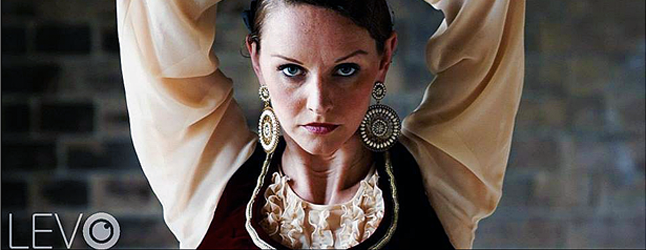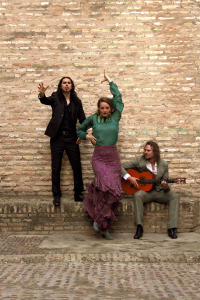
Dancer Lia Grainger was once a collegiate-level basketball player in her hometown of Vancouver and then an award-winning journalist, but she threw it all away to become a professional flamenco dancer, a feat that once seemed impossible for the 6’2” blond-haired, green-eyed Canadian.
No sooner had Dennis Duffin graduated with a PhD in Astrophysics from McMaster University than he left Ontario to pursue his love of flamenco and went to live in Sevilla (Spanish for the city English speakers know as Seville) to study guitar with the best in the world.
The two artists are behind Fin de Fiesta Flamenco, which plays at the Revelastoke United Church on August 7 at 8 pm. The two turned their backs on ‘normal’ lives in order to devote themselves entirely to their true passion — flamenco. Today, they spend as much time in Spain as they do in Canada. They aren’t the only foreigners to make this move. Seville is populated by almost as many flamenco students as tourists. There are dancers and guitarists, young and old, from all around the world who have chosen to give up everything and move to Spain to commit themselves full-time to the study and performance of flamenco.
If you have ever seen professional flamenco you’ll understand why. Flamenco is intensely and deeply hot-blooded music and dance that originated in the Andalusia region of Spain and was first mentioned in Spanish literature in 1774 and underwent an explosion in popularity in the 19th century. In recent years flamenco has become popular all over the world and is taught in many countries. In Japan, for instance, there are more flamenco academies than there are in Spain. In 2010 UNESCO declared flamenco one of the Masterpieces of the Oral and Intangible Heritage of Humanity.
Palos, formerly known as cantes, are flamenco styles, classified by criteria such as rhythmic pattern, mode, chord progression, stanzaic form and geographic origin. There are over 50 different palos, although some are rarely performed; only about a dozen of these, according to Wikipedia, are commonly played. Some are sung unaccompanied while others usually have guitar or other accompaniment. Some forms are danced while others are not. Some are reserved for men and others for women while some may be performed by either, though these traditional distinctions are breaking down: the Farruca, for example, once a male dance, is now commonly performed by women too.
Palos traditionally fall into three classes: the most serious is known as cante jondo (or cante grande), while lighter, frivolous forms are called cante chico. Forms that do not fit either category are classed as cante intermedio. Cante jondo has clear traces of Arabic and Spanish folk melodies, as well as vestiges of Byzantine, Christian and Jewish religious music.
As you can see — and hear — in the video of Lia Grainger performing at the World Flamenco Festival, Flamenqueria, in Sevilla in March at the bottom of this story, the rhythms and staccato dance steps associated with flamenco are familiar yet exotic, riveting and seductive and it is not at all difficult to understand flamenco’s appeal.
In 2012, Grainger decided to bring this Spanish inspiration to Canadian soil by forming Fin de Fiesta, an ensemble of esteemed Canadian and American flamenco artists who divide their time between North America and Seville, Spain. Fin de Fiesta has been presenting electric performances with a wide range of guest artists at festivals and theatres across the continent ever since.
“I’m thrilled to be bringing the music and dance of Spain to BC,” says Lia Grainger. “We’ve worked so hard in Spain to create this work, and I feel lucky to be able to perform it my home city, and in the places I visited and loved as a child.”
The name Fin de Fiesta translates as End of the Party, a reference to the open jam session that happens at the end of a traditional flamenco show in Spain. This is when the true improvisational and spirited nature of flamenco shows itself. It is this lively spirit – unpredictable and unrestrained – that inspires their work.
The Revelstoke show starts at 8 pm. Tickets are $17 in advance, $20 at the door. Please click here to visit the Fin de Fiesta website and read about all of the amazing performers as well as purchase your online tickets.



